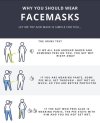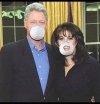So, am I not correct? Healthy people do get protection from a non-N95 mask ( I specified non-N95 earlier, Pags) just like the guy peed on above. So why are we told it dosen't help the healthy from getting COVID? Not as effective as it is on sick guy, I get that. But ineffective or harmful?
My understanding is that a cotton mask does provide some protection to both the wearer and the everyone else.
First, let's bound the problem. On one side is no mask which offers no additional protection above normal luck. On the other side is your outbreak space suit thing people wear in high risk labs or MOPP level 4 that provides full protection.
The other piece is how the virus works. My understanding (internet deep) is that it needs to get in to your mucus membranes such as your nose or eyes, upper nose being the preferred path. If someone coughs on your back and no where else and you should be fine. If someone sneezes up your nose that's bad. The virus can fly around on sneeze and cough droplets that have a WEZ of under 6' (hence social distance guidelines). There's some data from hospitals that says it may be able to float around in the air for awhile, no idea how long it can float around at nose level at the grocery store.
So, what this means is you need to prevent the virus from getting in to your upper nose. So even if you didn't have a mask and someone sick sneezed there's a chance that none of the droplets make it far enough up your nose to get you sick (nose hairs work as designed). So now you put double thick cotton masks on everyone. First off, if a sick person sneezes it now goes in to the mask. The two layers of cotton will absorb some of the droplets. Then, the droplets (fewer than a non masked sneeze) that are out in the air will land on your mask and not up your nose. Now your mask will stop some of these droplets. I'd imagine distance from the sneezer matters. If you're 2" away the drops may still have enough velocity to get through the cotton. If you're farther away, say 6', then the droplets aren't moving fast and theyll be less likely to get through your mask. So now that the sneezer had a mask, you were far apart, and you had a mask, the amount of drops that could get to your nose are far less than before. It's not perfect but it's better than nothing and it reduces your risk. In addition, masks also stop you from touching your face. Without a mask someone could sneeze on your hand and then you rub your nose and you're now exposed. With a mask, someone could still sneeze on your hand but then when you go to wipe your nose you hit your mask. So again, not perfect, but still some degree of protection.
Or, to keep up the pee analogy, you don't want pee in your mouth. Some weirdo is running around with no pants peeing. So, you stay 6' away to stay out of the stream and the splash zone. But, sometimes you can't stay 6' away so you wear a mask. That way, if some pee gets on your hand it won't get in your mouth. Or, if the pee splashes on your mask hopefully the mask gets wet but none goes in your throat. By wearing a mask you've reduced your chances of getting pee in your mouth.
Thus concludes your PI libo brief. Also, wrap your tool.





